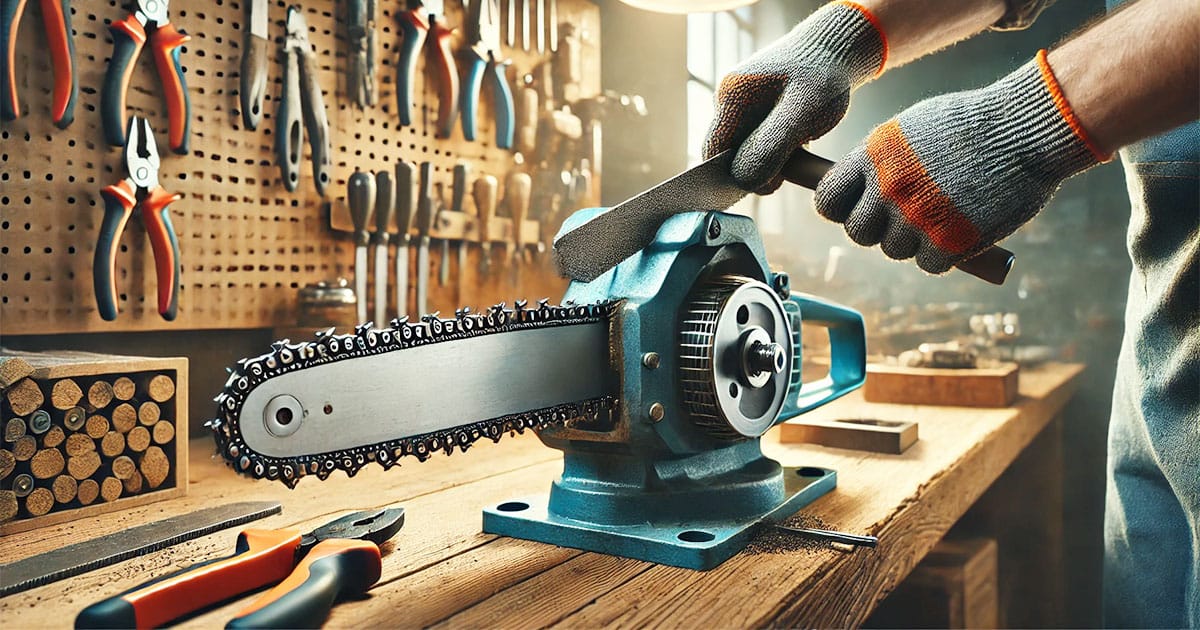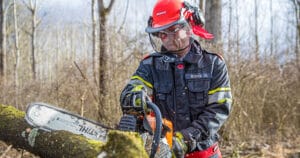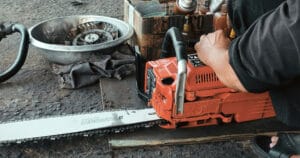Sharpening a chainsaw helps it work its best. A sharp chain cuts quicker, puts less stress on the motor, and needs less effort from you. It makes cleaner and smoother cuts, saving time and energy. Sharpening often also stops damage and makes your chainsaw last longer. Keeping it sharp improves how it works and makes it safer to use.
Key Takeaways
- Sharpen your chainsaw every 3-5 hours to keep it safe.
- Check for dullness, like fine sawdust or uneven cutting.
- Use tools like a round file and a guide to sharpen well.
- Wear safety gear and secure the chainsaw before sharpening.
- Clean and oil your chainsaw often to make it last longer.
Table of Contents
When to Sharpen a Chainsaw
Knowing when to sharpen a chainsaw is very important. A dull chain slows cutting and raises accident risks. Spotting dullness early and sharpening on time keeps it working well.
Signs of a Dull Chainsaw
A dull chainsaw shows clear signs you can notice easily. Look for these:
- It makes fine sawdust, not big wood chips.
- The chain cuts unevenly or pulls to one side.
- Cutting wood takes more effort than usual.
- Smoke appears, even with proper chain oiling.
These signs mean the chain isn’t sharp enough anymore. Ignoring them can harm performance and strain the motor.
Frequency of Sharpening
How often you sharpen depends on the type of wood used. Experts say to sharpen every 3-5 hours of cutting. Hardwoods need sharpening more often than softwoods.
Studies show 77% of chainsaws are replaced too soon. Chains could be sharpened 4-5 more times before replacement. Regular sharpening helps your chainsaw last longer and work better.
By following these tips, you can keep your chainsaw sharp and extend its life.
Tools for Sharpening a Chainsaw
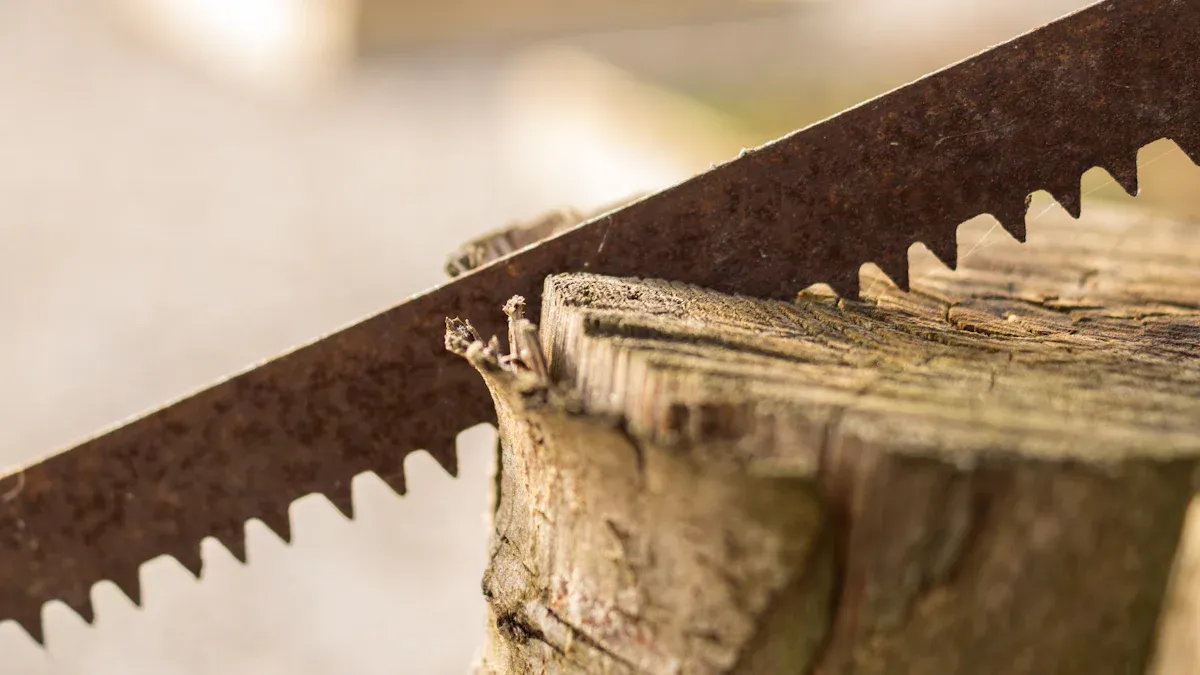
Having the right tools is key to sharpening a chainsaw well. Good tools make the job easier, faster, and keep your chainsaw working great. Below is a list of must-have tools and extra tools that can help.
Essential Tools
You need a few basic tools to sharpen your chainsaw. These are important for keeping your chainsaw cutting properly:
- Round File: Matches the size of your chain’s teeth. It sharpens the cutting edges to make them sharp again.
- File Guide: Helps you hold the file at the correct angle. This keeps all teeth sharpened evenly.
- Flat File: Adjusts the depth gauges (also called rakers) on the chain. Correct depth gauges make cutting smooth and easy.
- Depth Gauge Tool: Measures the height of the depth gauges. It helps you file them to the right level.
These tools are cheap and simple to use. They are great for beginners and experts. Tests show manual tools like round files and guides are affordable and work well for occasional users. They also let you sharpen specific chain sizes accurately.
Optional Tools for Precision
For better results, you can try these extra tools. They make sharpening easier and more precise, especially if you use your chainsaw a lot:
- Electric Chainsaw Sharpener: This tool sharpens the chain automatically. Set the angles, and it sharpens quickly. It’s great for frequent users or sharpening many chains. Tests show it saves time and gives consistent results.
- Sharpening Stones: Attach to rotary tools for quick sharpening. They wear out fast, so they’re best for light use.
- Angle Guide: Keeps the sharpening angle correct. It’s helpful for beginners. Tests show it improves accuracy and reduces sharpening time.
| Specification | Value |
|---|---|
| Bit Diameter (Inch) | 7/32″ |
| Bit Diameter (mm) | 5.6 mm |
| Model Number | 455 |
| RPM | 35000.0 |
| Recommended Speeds | 25,000-35,000 RPM |
| Shank Diameter (in) | 0.125 |
| Size (in) | 7/32 In. |
| Warranty | Product Defects Only – 1 Year |
Comparing sharpening tools shows the pros of different brands like STIHL, Granberg, and Oregon. Electric sharpeners are fast and consistent, while manual tools are cheaper and good for occasional use.
Picking the right tools makes sharpening easier and faster. Whether you stick to basics or buy advanced tools, keeping your chain sharp will improve your chainsaw’s performance and make it last longer.
Step-by-Step Guide to Sharpening a Chainsaw

Sharpening a chainsaw is simple if you follow clear steps. Preparing well, focusing on details, and using the right method help your chainsaw work better and last longer. This guide explains each step clearly.
Getting the Chainsaw Ready
Before sharpening, prepare your chainsaw for safety and accuracy. Do these steps:
- Secure the Chainsaw: Put it on a steady surface or clamp it in a bench vise. This stops it from moving while you sharpen.
- Clean the Chain: Wipe off dirt, oil, and debris with a brush or cloth. A clean chain makes sharpening easier and more accurate.
- Inspect the Chain: Look for broken or worn teeth. Replace the chain if needed.
- Wear Safety Gear: Use gloves, goggles, and ear protection to stay safe while working.
Tip: Always check the safety manual that comes with your chainsaw. It has important rules for safe use and care.
Sharpening the Chain Teeth
Fixing the chain teeth is the most important part of sharpening. Use the right tools and steps to make the edges sharp again:
- Pick the Right File Size: Look in your chainsaw’s manual to find the correct file size for the teeth.
- Set the File Angle: Place the round file in the cutter at the suggested angle (usually 25-30 degrees).
- Sharpen Each Tooth: Push the file across the cutter in one direction with steady pressure. Don’t file back and forth.
- Count Strokes: File each tooth the same number of times to keep them equally sharp.
- Move the Chain: Turn the chain to sharpen all the teeth.
| Sharpening Method | Speed | Accuracy | Advantages | Disadvantages |
|---|---|---|---|---|
| Manual Sharpening with a File | Slow | Uneven | Cheap, easy to carry | Hard work, needs practice |
| Electric Bench Sharpeners | Quick | Precise | Gives professional sharpness | Big size, costs more |
Note: A file guide helps keep the angle correct. It’s useful for beginners learning to sharpen chainsaws.
Adjusting the Depth Gauges
Depth gauges decide how deeply the teeth cut into wood. Fixing them makes cutting smoother and easier:
- Measure the Height: Use a depth gauge tool to check each gauge’s height.
- File Down Gauges: Use a flat file to lower gauges that are too tall. File outward for better results.
- Keep Them Even: Make sure all gauges are filed to the same height for balanced cutting.
Carlton suggests a depth of 63 thou for best results. Some tools may only adjust up to 47 thou. Follow your chainsaw maker’s instructions.
By following these steps, you’ll keep your chainsaw sharp and ready to use. Regular sharpening improves cutting and helps your chainsaw last longer.
Final Inspection
After sharpening, always check your chainsaw to ensure it’s safe and ready. This step makes sure the chain is sharp and properly aligned, avoiding problems while cutting.
- Check for Over-Filing: Look at the teeth to see if they’re over-filed. Over-filing weakens the chain and shortens its life. Filing correctly can make the chain last 50% longer. If teeth are filed too much, replace the chain to avoid issues.
- Verify the Angles: Use a file guide to check each tooth’s angle. Wrong angles cause uneven cuts and lower efficiency. Keeping all teeth at the same angle ensures smooth cutting.
- Inspect the Depth Gauges: Use a depth gauge tool to measure the height of the gauges. If they’re uneven or too tall, cutting becomes harder and strains the motor. File them to the right height for better performance.
- Clean the Chain Again: Wipe the chain with a cloth to remove leftover metal bits or dirt. A clean chain works better and reduces wear on parts.
Tip: Turn the chain by hand to check if it moves smoothly. If it feels stuck or uneven, adjust the alignment and tension.
Carefully inspecting your chainsaw ensures it’s in great shape. Taking time to double-check your work helps avoid mistakes and keeps the chain ready for use.
Safety Tips for Sharpening a Chainsaw
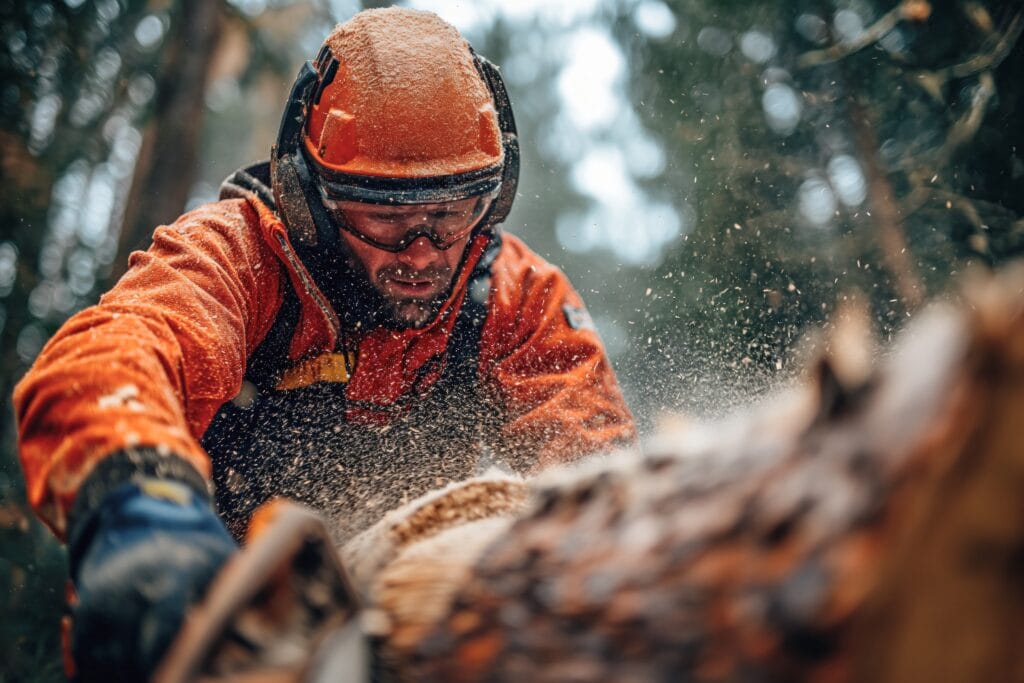
Sharpening a chainsaw needs careful attention to safety. Chainsaws are strong tools, and mistakes during maintenance can cause injuries. These safety tips will help you stay safe and sharpen correctly.
Protective Gear
Wearing safety gear is very important when sharpening a chainsaw. Each item protects you in a specific way.
| Safety Equipment | Purpose |
|---|---|
| Chaps | Guards the head and face from falling objects |
| Protective Helmet | Guard hthe ead and face from falling objects |
| Rope Rescue System | Keeps you safe when working up high |
Check your gear often for damage or wear. Even small problems can make it unsafe. Pick a helmet with a strong face shield that meets safety rules. Use comfortable eye protection that covers your eyes fully. Protect your ears too, as chainsaws are very loud and can harm your hearing over time.
Tip: Store your safety gear in a dry, clean spot to make it last longer.
Proper Chainsaw Securing
Securing the chainsaw well stops accidents and helps with accuracy. Follow these steps to set it up safely:
- Hold the chainsaw steady in a vice or clamp. This keeps it from moving while you work.
- Line up each tooth so its edge makes a 30-degree angle with the tool. Check your manual for the right angle for your chainsaw.
- Slowly turn the chain through the tool, filing both sides evenly.
A steady chainsaw lowers the chance of slipping, which can hurt you or mess up sharpening. Taking time to secure it makes the job safer and easier.
Avoiding Common Mistakes
Mistakes during sharpening can harm your chainsaw’s safety and performance. Avoid these errors:
- Putting the blade on backward makes cutting harder.
- Misaligning chain links can cause safety problems.
- Skipping checks for wear, which can lead to issues later.
- Using the wrong sharpening methods which dull the chain faster.
Paying attention to these things will keep your chainsaw working well and lasting longer.
Note: Always check your work after sharpening to make sure everything is correct and safe.
By following these safety tips, you can sharpen your chainsaw safely and confidently. Being prepared and careful will protect you and keep your chainsaw in top shape.
Maintenance Tips for Chainsaw Efficiency
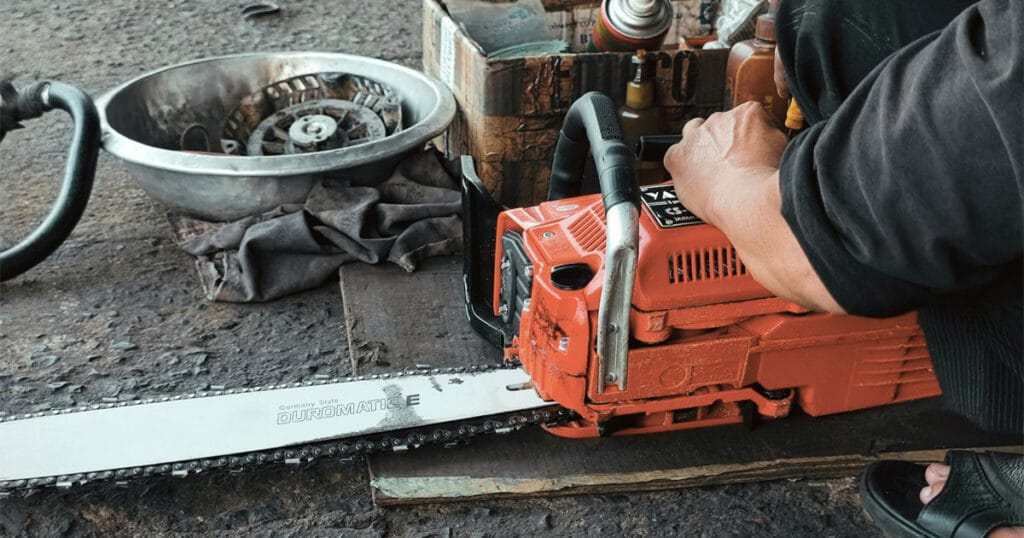
Taking care of your chainsaw keeps it working well. Regular maintenance helps it last longer and avoids expensive repairs. Use these tips to keep your chainsaw in great shape.
Cleaning and Lubrication
Cleaning and oiling are key to keeping your chainsaw efficient. Dirt can block parts, and no oil causes damage.
- Use good-quality bar and chain oil to stop friction and overheating.
- Check the oil often and refill it to avoid running dry.
- Make sure the oiling system works by cleaning the ports and removing dirt.
Oiling protects the chain and bar, making them last longer. Add oiling to your routine and check the chain often to avoid damage.
Proper Storage
Storing your chainsaw the right way stops rust and other problems. Follow these steps to store it safely:
- Empty the fuel tank before storing to prevent leaks or clogs.
- Add a fuel stabilizer if storing for a long time.
- Keep the chainsaw in a dry, clean place to avoid moisture.
- Cover it with a case to protect it from dirt and damage.
A properly stored chainsaw stays in better shape and needs less fixing later.
Replacing Worn Parts
Old parts can make your chainsaw unsafe and less effective. Check your chainsaw often and replace broken parts quickly.
- Look at the chain for wear, like broken teeth or loose tension. Replace it if needed.
- Check the bar for cracks or bends. A damaged bar should be replaced to cut properly.
- Inspect the spark plug and air filter. Change them regularly to keep the engine running well.
Getting a professional check-up can help find hidden problems. Replacing worn parts on time keeps your chainsaw safe and reliable.
Tip: Always read your chainsaw’s manual for specific care tips and part details.
By following these steps, your chainsaw will work better and last longer, giving you safer and smoother use.
Final Verdict
Sharpening your chainsaw often helps it work better. It cuts smoother, protects the engine, and makes your tool last longer. Keeping the sharpening angle at 25 degrees improves cutting and keeps the chain even. Fixing the depth gauge stops extra wear and tear. Regular sharpening saves time, lowers effort, and keeps your chainsaw ready to use anytime.
FAQ
How often should you sharpen a chainsaw?
Sharpen your chainsaw after 3–5 hours of cutting. Hardwoods make the chain dull faster than softwoods. Regular sharpening helps it work well and protects the motor.
Can you sharpen a chainsaw without special tools?
Yes, basic tools like a round file and file guide work. They are cheap and simple to use. Advanced tools, like electric sharpeners, save time and give better results.
What happens if you don’t sharpen your chainsaw?
A dull chainsaw cuts more slowly and unevenly. It makes the motor work harder and raises accident risks. Sharpening often keeps cuts smooth and extends the chainsaw’s life.
How do you know if the chain is sharp enough?
Look for clean cuts and big wood chips, not sawdust. A sharp chain cuts easily and doesn’t make smoke while cutting.
Is it better to sharpen manually or use an electric sharpener?
Manual sharpening is cheaper and easier to carry, and good for light use. Electric sharpeners are quicker and more accurate, great for frequent users or pros.

